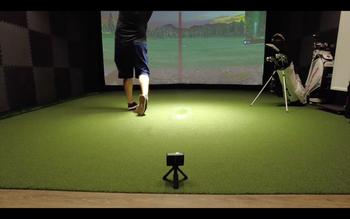A standard 18-hole golf course measures about 6,600 yards (3.75 miles) from tee to green, but you'll actually walk much farther during your round. While the scorecard shows the direct yardage, your actual walking distance typically ranges from 4 to 4.5 miles, thanks to walking between shots, maneuvering around hazards, and tracking down errant drives. You'll burn between 800 and 1,500 calories during this trek, making it a solid workout. The course's length can vary considerably based on tee box selection, course conditions, and layout design - factors that'll shape your entire golfing experience.
Standard Golf Course Length
Modern golf courses stretch an impressive 6,600 yards on average, equivalent to roughly 3.75 miles of carefully designed terrain. If you're playing on a professional-level course, you'll find yourself traversing even greater distances, typically between 6,500 and 7,200 yards, which is quite the workout for both your legs and your swing stamina.
You might be interested to know that golf courses haven't always been this lengthy. Over the past century, you've seen the median course length grow from a modest 5,600 yards to today's more challenging 6,800 yards.
That's about 10 yards of additional length per year, and there's a fascinating reason behind this growth: your golf equipment keeps getting better! As manufacturers have developed more sophisticated clubs and balls that allow you to hit farther than ever before, course designers have responded by stretching out their layouts to maintain the game's challenge.
It's like an architectural arms race between your improving technology and the courses trying to keep pace with your improved playing capabilities. Course designers carefully consider tee box placement to add strategic distance and complexity to each hole.
Walking Vs Scorecard Distance
Those impressive course lengths you see on the scorecard tell only part of the story.
In reality, you'll walk considerably more than the listed yardage, often covering up to 77% extra distance throughout your round. Between walking to your ball, maneuvering around bunkers, and searching for those occasional wayward shots, you're actually getting quite a workout. An average round of golf can burn 800 to 1,500 calories.
Mid-handicappers, curiously enough, tend to rack up the most mileage, walking about 80% further than the scorecard distance. This makes sense when you consider all the extra steps taken to manage different course situations and shot selections.
To calculate your likely walking distance, multiply the course's yardage by 3 to convert to feet, then divide by 5,280 for miles. You'll want to add roughly another mile to account for the zig-zagging nature of your path, plus pre and post-round activities.
When all's said and done, you're looking at approximately 4 to 4.5 miles of walking during a typical 18-hole round, which explains why you might feel those extra steps in your legs afterward!
Factors Affecting Course Length

A golf course's length is shaped by numerous interconnected factors, from the basic layout requirements to specific design elements. You'll find that the total yardage isn't just about straight-line distances - it's influenced by everything from tee box positioning to the way fairways are configured. An 18-hole course typically spans between 5000 and 7500 yards in total length.
When you're playing, you'll notice that course conditions play a significant role in how long the course "plays." Wet, lush grass can dramatically slow your ball's roll, while firm, dry conditions might add yards to your shots. The strategic placement of hazards, such as water features and bunkers, can force you to take longer routes around the course, effectively increasing its playing length.
The course architect's design choices also impact the total length you'll traverse. Forced layups, doglegs, and elevation changes all affect how far you'll actually need to hit the ball to reach your target.
Even the positioning of tee boxes, which can add 10-20 yards before you reach the fairway, contributes to the comprehensive distance you'll need to cover during your round.
Course Types and Measurements
Golf courses come in a wide range of sizes and configurations, from compact 9-hole layouts up to sprawling 27-hole complexes. When you're looking at standard 18-hole courses, you'll typically find they measure between 5,000 and 7,500 yards in total length, with most requiring 120-200 acres of land to accommodate their full design. The American Society of Golf Course Architects suggests that 200 acres is ideal for creating a standard par-72 course.
You'll notice that courses follow standardized measurement protocols, with distances calculated from diverse tee positions (marked by different colors) to the center of each green. While a traditional par-72 course is most common, you'll also encounter shorter par-68 layouts or slightly longer par-74 designs.
If you're pressed for time or just starting out, you might want to try a 9-hole course, which requires less land and can be played twice for a full round. For those seeking variety, some facilities offer 27 holes, letting you mix and match different 9-hole combinations.
You'll also find specialized short courses, like par-3 layouts that can fit on just 30 acres, making golf more accessible in urban areas where space is at a premium.
Rating Systems and Difficulty Levels
Understanding a course's true challenge goes beyond its physical measurements, thanks to standardized rating systems that help players gauge difficulty levels. You'll encounter two key metrics: Course Rating, which measures the challenge for a bogey golfer, and Slope Rating, which indicates relative difficulty for players of varying skill levels compared to scratch golfers.
When you're selecting a course to play, you'll want to take these ratings carefully into account. Course Ratings reflect factors like distance, obstacles, and terrain, while Slope Ratings range from 55 to 155, with 113 being the standard baseline. Most golfers will walk an average of 6.6 miles during their round, which can significantly impact energy levels and performance.
These numbers aren't just random figures - they're essential for calculating your handicap and determining how the course will play for your skill level. You'll find that different tee positions on the same course have distinct ratings, allowing you to choose the most appropriate challenge for your game.
This standardized system guarantees you're comparing apples to apples when discussing course difficulty with fellow golfers, and it's particularly helpful when you're playing on unfamiliar courses or participating in tournaments.
Frequently Asked Questions
How Much Time Should I Allow Between Tee Times at My Course?
Set your tee times 10-12 minutes apart to keep things flowing smoothly. If you've got a challenging course or you're usually busy, it's best to go with 12-minute gaps to avoid backups.
What's the Maximum Number of Golfers Allowed in a Single Group?
You should keep your golf group to four players since that's what most courses allow. Even though some private clubs might be more flexible, they typically won't let you play with five or more people.
Do Golf Courses Have Minimum Age Requirements for Playing 18 Holes?
You won't find many golf courses with set age limits, but some do have their own rules about how old you need to be to play. They'll usually ask kids to have an adult with them on the course.
Can I Play 18 Holes Alone, or Must I Join Others?
You'll zip through 18 holes on your own in just 2-3 hours! While most courses let singles play, they might pair you up with other golfers during peak times to keep things moving smoothly.
How Does Weather Affect the Recommended Spacing Between Groups on Course?
You'll need wider spacing between groups during adverse weather. Rain and wind can slow play by 15-20%, so it's best to increase standard tee time intervals from 8-10 minutes to 12-15.
Conclusion
Like a marathon stretched across manicured fairways, your typical 18-hole round of golf will take you between 3.5 to 4.5 hours to complete. You'll find this time varies based on your playing style, course difficulty, and whether you're walking or riding. While the standard course length hovers around 6,500 yards, you're actually covering more ground when factoring in walks between shots and searching for those occasional wayward balls.





